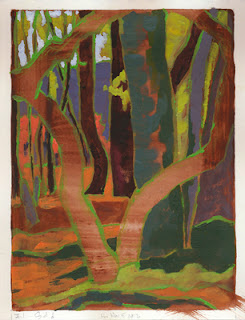Caspar David Friedrich, Romanticism, Penrose, and the 5th Dimension
 I am embarrassed to admit that I have been working on this painting since before Émile was born (sorry about that accent over the E-- I can't give it up yet!) For many painters this would be an insignificant amount of time, but I like to conceive and produce my paintings in about a week's time. This one is kind of an homage to Caspar David Friedrich.
I am embarrassed to admit that I have been working on this painting since before Émile was born (sorry about that accent over the E-- I can't give it up yet!) For many painters this would be an insignificant amount of time, but I like to conceive and produce my paintings in about a week's time. This one is kind of an homage to Caspar David Friedrich.A couple of words about the background. This is one possible solution to the shapes and rules set forth by Sir Arthur Penrose (and copyrighted by him, too.
 Here is a funny article on what happened when a toilet paper company used his design without permission.) I have a fond relationship with these tiles, or tessellations as some people call them, when a set of forms can fill space without gaps to infinity by following some basic rules. Penrose tiles have the distinguishing feature that they can tile space infinitely, but you can't predict their patterns. At least, not in this dimension (oooohh...)
Here is a funny article on what happened when a toilet paper company used his design without permission.) I have a fond relationship with these tiles, or tessellations as some people call them, when a set of forms can fill space without gaps to infinity by following some basic rules. Penrose tiles have the distinguishing feature that they can tile space infinitely, but you can't predict their patterns. At least, not in this dimension (oooohh...)In college, I had a class with a brilliant woman, Marjorie Senechal. She taught us discrete mathematics, and a class on tilings, both of which were thoroughly enjoyable classes. In addition, she looked strikingly like the white queen from Tenniel's illustrations for Through the Looking Glass.
Professor Senechal is a world expert on quasicrystals, and predicting semi-regular tilings. She wrote the book, which sits admired and misunderstood on my shelf, Quasicrystals and Geometry.
Quasicrystals are described as "periodic in a higher dimension," which I find pretty trippy stuff. What does this have to do with Penrose tiles? Well, apparently, if you bisect each side of the tiles, and connect the ones that are parrallel and share a tile,
 you end up with 5 sets of lines, which can then be stretched straight. Then, through a process called "abracadabra," you turn each of those sets into another dimension, and then, somehow, they are predictable. I don't get it, but I love the idea.
you end up with 5 sets of lines, which can then be stretched straight. Then, through a process called "abracadabra," you turn each of those sets into another dimension, and then, somehow, they are predictable. I don't get it, but I love the idea.Penrose tiles are a rich symbol for me of all of the mathematics I studied, and loved, even when I wasn't always very good at it, or didn't understand it. I left it all behind when I started studying art more seriously. Maybe I will go back and get a phD in math when I'm an old woman...
I remember sitting on this bench in Amsterdam, covered with Penrose tiles! (photo by Javier Lopez.)




Comments
Post a Comment